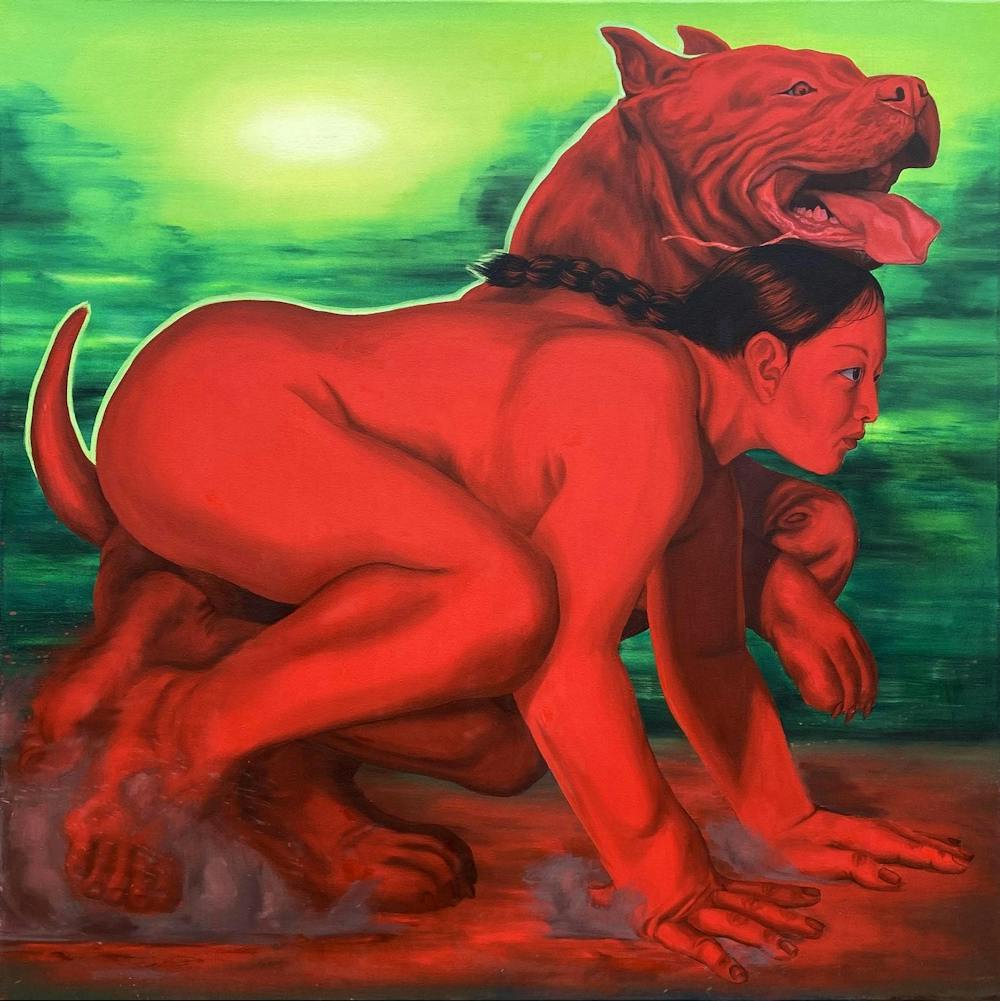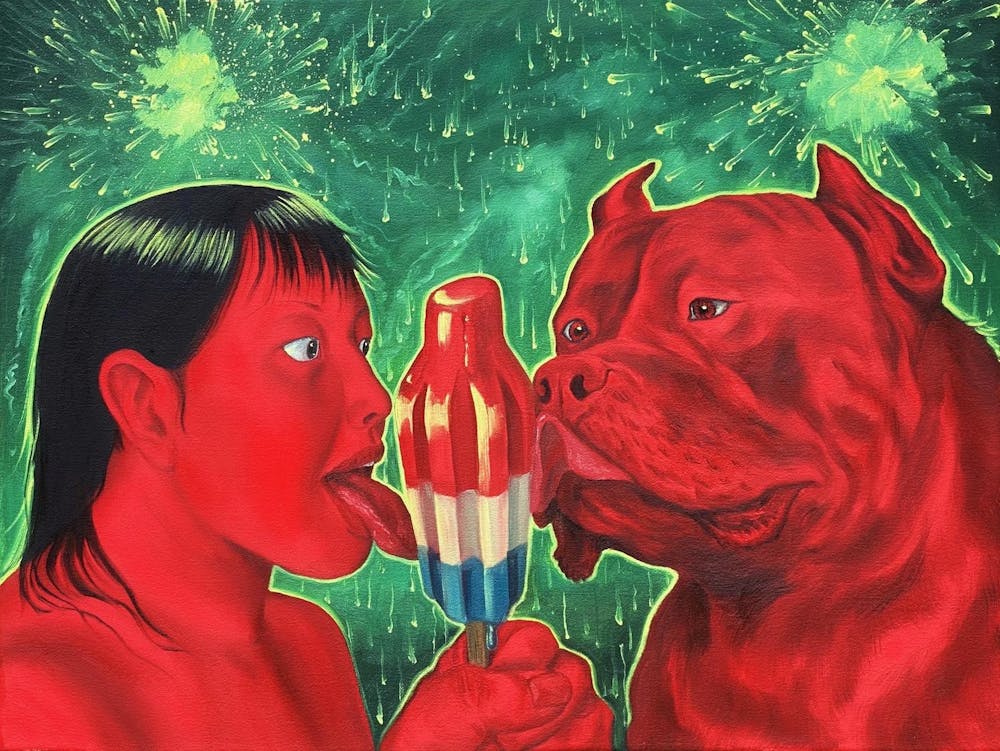As every Penn student knows, the rat race can be exhausting. It’s easy to get wrapped up in the endless cycle of club applications, internships, and homework. If you’ve ever been seized by a sudden desire to let your hair down, know you’re not alone. London-based artist Amanda Ba has tapped into our shared impulse to run with the wolves—or dogs, in this case. Hailing from New York City (by way of Hefei, China), Ba’s paintings collapse the distinction between the human and animal.
In her vivid double portraits, all our human confections are still present—but transformed. Under the cast of Ba’s lime–green light, everyday objects become alien: Popsicles shimmer like tropical coral, chairs and tables wobble as if they are kelp. Thus, Ba’s female subjects inhabit a world infinitely more vital and instinctive than our own. Civilization recedes into the background; all that matters here are bodies, rendered earthy and solid under Ba’s brush.
The artist is at ease with provocation. Her female subjects confidently stretch and sit in the nude, their paw–like hands and feet anchoring simple compositions. With her palette relying mainly on flytrap green and electric red, Ba literally paints in the red zone. In her best, most illustrative works, she channels female confidence to the maximum. In the aptly–titled Suburban Giantess, Ba’s most explicit work, a woman stands and bares her crotch to the viewer, a slobbering dog nestled between her legs. The subject’s warrior–like stance recalls the moment before a battle charge; in her expectant gaze, we can almost discern a dare. Whether to join or to flee is up to the viewer.

Amanda Ba
Suburban Giantess, 2021
Oil on canvas, 190 x 170 cm
Artwork © 2021 Amanda Ba
Photo courtesy of Amanda Ba
This balance between invitation and provocation is a Ba hallmark. In American Girl; American Bully; American Bomb, she interrogates our toxic national iconography; a half–melted red, white, and blue popsicle leaps from a background of noxious green fireworks. Ba questions whether natural instinct will free us from America’s romance with hollow symbols, or whether it merely leads us deeper into consumption. Whatever the answer, woman and dog are in the same boat, both delighting in the popsicle at the feverish painting's center.
Yet, as in nature, there are moments of tranquility. In the intimate Lover; She is Reading, the gracefully contemplative figure evokes an unexpected tenderness. Lying atop a couch, her hand barely touches the furniture. Ba’s eye reverently lingers on her lover’s body to soothing effect.
But even in these uninhibited scenes, appearances can be deceiving. Underneath all the rawness, Ba’s compositions are calculated. Her approach is grounded in critical theory, particularly gender scholar Mel Y. Chen’s 2012 work, Animacies: Biopolitics, Racial Mattering, and Queer Affect. (The book even makes a cameo in Lover, haphazardly laid on a coffee table.)

Amanda Ba
Lover; She is Reading, 2021
Oil on canvas, 84 x 66 in
Artwork © 2021 Amanda Ba
Photo courtesy of Amanda Ba
In Animacies, Chen examines the dehumanization faced by early Chinese immigrants. There is history here, painfully vivid; Chen describes a 19th–century illustration of a white man attacking a caricatured Chinese immigrant, wherein the well–worn trope of the “passive” Chinese man meets a particularly nauseating iteration. “[T]he Chinese man is presented as an ungainly figure who appears to float or flail next to the stout white man whose legs are solidly planted on the ground.” Most damningly, the man is depicted as barely solid, almost ghostly. This wound still smarts in the Chinese–American Ba’s work, and she actively subverts this sickening trope.
With her figures firmly planted on the ground—even when reclining, stretching, or Running Towards the Future—Ba obliterates the stereotype depicted above. Resolute to the point of stoicism, her subjects stare down the viewer, leaving no doubts as to their power. They’re here, standing strong and holding fast.

Amanda Ba
Running on All Fours Towards the Future, 2021
Oil on canvas, 100 x 100 cm
Artwork © 2021 Amanda Ba/PM/AM Gallery, London
Photo courtesy of Amanda Ba
Here viewers can discern another one of the artist’s conceptual influences: Donna Haraway’s The Companion Species Manifesto: Dogs, People, and Significant Otherness, which argues that dogs and people are “constitutively, companion species. We make each other up, in the flesh. [W]e signify [...] a nasty developmental infection called love.” Ba’s figures, born of the implosion of species categories, are the purest expression of love.
In the end, these paintings, in all their rawness, are not evasive but confrontational. Ba’s not afraid of the havoc of nature; her paintings point a finger at the viewer, demanding us to abandon human inventions both concrete and abstract and heed the call of the wild.

